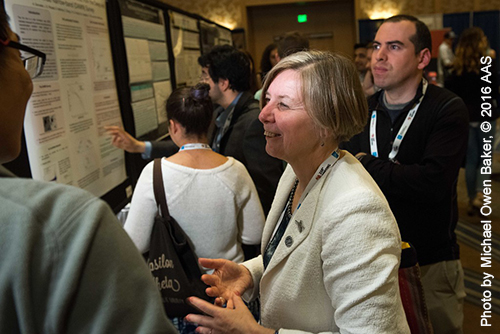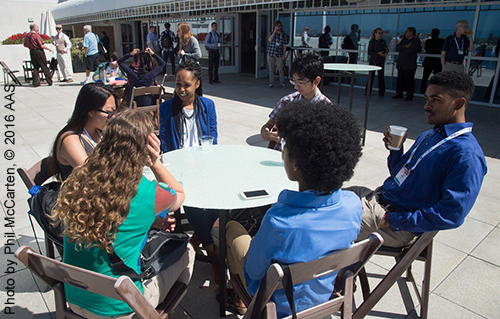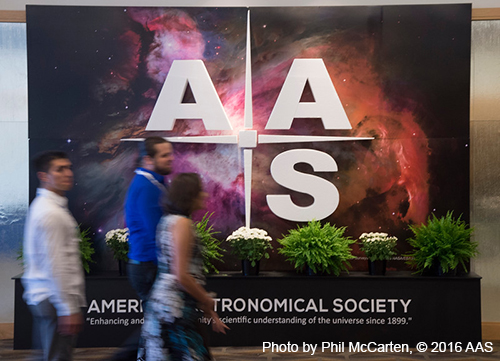How Can AAS Meetings Be Improved? Part 2
Stephen Unwin JPL
This is the second of two articles about the future of AAS meetings. Part 1 discussed the big-picture view of the purpose of AAS meetings and addressed the needs of the membership. Here I summarize some of the specific questions addressed by the AAS Meetings Task Force that I chaired. Much more detail is available in the task force report, including a summary of the meetings survey that documents a large body of feedback from members on every aspect of our meetings.
As mentioned in Part 1, meeting cost (including travel, lodging, and registration) remains a major concern for members, especially for the winter meeting. Meeting city and venue generated a lot of comment by members, many of whom have strong feelings on the subject. The Gaylord locations generated a lot of vocal feedback, almost all negative — the isolated locations made it hard for cost-conscious attendees to find alternative accommodation and meals at lower cost. As our winter meeting attendance has grown, we have outgrown some of the locations we used in the past, including downtown Washington, DC, which was popular with members. By industry standards our winter meeting is mid-size — too large for most hotel-based venues, and too small to be cost effective at large convention centers.
The task force recommended that the AAS consider reducing its dependence on room blocks at venues that are combined with meeting facilities. This allows attendees to take advantage of cheaper hotels and lodgings in the "sharing economy," but one possible consequence is a higher registration fee, and another is an increase in cost for the large number of members who value the convenience of staying at the meeting hotel.
Meeting content is also evolving. The online meeting app has proved very popular, allowing attendees to select from an ever-increasing number of session options. Some members complained about too many parallel sessions and having to choose which to attend. The task force felt that having lots of choices is actually a strength of the meetings, as it encourages exploration of new research areas. The AAS can improve how the contributed sessions are scheduled to minimize clashes on similar topics. There was little enthusiasm for reducing conflicts by extending the meetings beyond four days, especially as there are many popular workshops on the adjacent weekend, extending the meeting to five or six days for many attendees. Review-style plenary talks continue to be popular, and schedules will continue to mostly avoid competing activities at those times.
 A number of task force recommendations can be implemented on a trial basis. For example, are "poster pops" — 1-minute advertisements for poster papers — worth devoting session time to, as is frequently done at engineering conferences? More time for poster viewing was a frequent request. An easy, but not inexpensive, option would be to extend the evening poster session, which is always well-attended, by 30 to 60 minutes, allowing more time for poster viewing before dinner without affecting attendance at the oral sessions.
A number of task force recommendations can be implemented on a trial basis. For example, are "poster pops" — 1-minute advertisements for poster papers — worth devoting session time to, as is frequently done at engineering conferences? More time for poster viewing was a frequent request. An easy, but not inexpensive, option would be to extend the evening poster session, which is always well-attended, by 30 to 60 minutes, allowing more time for poster viewing before dinner without affecting attendance at the oral sessions.
The annual summer meeting generated a lot of task force discussion. We started with the question: Should the AAS discontinue the summer meeting? Summer meetings are always a lot smaller than the winter meetings, but size isn’t the only metric for meeting success. Eliminating summer meetings would place yet more pressure on the challenges of organizing effective winter meetings. Summer meetings remain popular with a major segment of the AAS membership, offering many of the same features as winter meetings but in more varied locations and in venues that are less crowded and easy to navigate. The San Diego meeting was a good example. Attendance was one of the smallest for several years (hotel cost may have been a factor), but the waterfront location was spectacular, there were many dining options nearby, and the venue was well suited to the meeting size. Personally, I felt it was one of the best summer locations we have used.
 Financially, the summer meetings represent uncertainty for the AAS, because attendance varies a lot. They compete, of course, with specialist meetings, which are often held in exotic locations; organizers of small meetings have many more options to be creative, for instance, using university conference and lodging facilities. The AAS summer meetings offer "Meeting-in-a-Meeting" (MiM) sessions that can achieve many of the goals of a two-day specialist workshop; there are many benefits of the MiM format to conference organizers, but this service is not widely recognized among potential workshop organizers. The task force recommended that the AAS continue the summer meetings, but assess every few years whether they remain viable from trends in attendance and meeting cost.
Financially, the summer meetings represent uncertainty for the AAS, because attendance varies a lot. They compete, of course, with specialist meetings, which are often held in exotic locations; organizers of small meetings have many more options to be creative, for instance, using university conference and lodging facilities. The AAS summer meetings offer "Meeting-in-a-Meeting" (MiM) sessions that can achieve many of the goals of a two-day specialist workshop; there are many benefits of the MiM format to conference organizers, but this service is not widely recognized among potential workshop organizers. The task force recommended that the AAS continue the summer meetings, but assess every few years whether they remain viable from trends in attendance and meeting cost.
Can we expect to see changes in AAS meetings over the next few years? The task force made a number of specific recommendations but did not advocate major changes. Our elected Vice-Presidents, who plan the science agenda, and the AAS staff, who organize the meetings, will use the task force recommendations when planning meetings.
 One final thought. The emphasis that the AAS places on providing a harassment-free environment at our meetings continues to grow in importance. As a profession, astronomy, along with many other science disciplines, still needs a lot of improvement in diversity, inclusion, and freedom from harassment. Our meetings are the public face of our profession, and it’s important that our intent to tackle these issues is clearly exhibited.
One final thought. The emphasis that the AAS places on providing a harassment-free environment at our meetings continues to grow in importance. As a profession, astronomy, along with many other science disciplines, still needs a lot of improvement in diversity, inclusion, and freedom from harassment. Our meetings are the public face of our profession, and it’s important that our intent to tackle these issues is clearly exhibited.
Steve Unwin
AAS Council
Meetings Task Force chair

